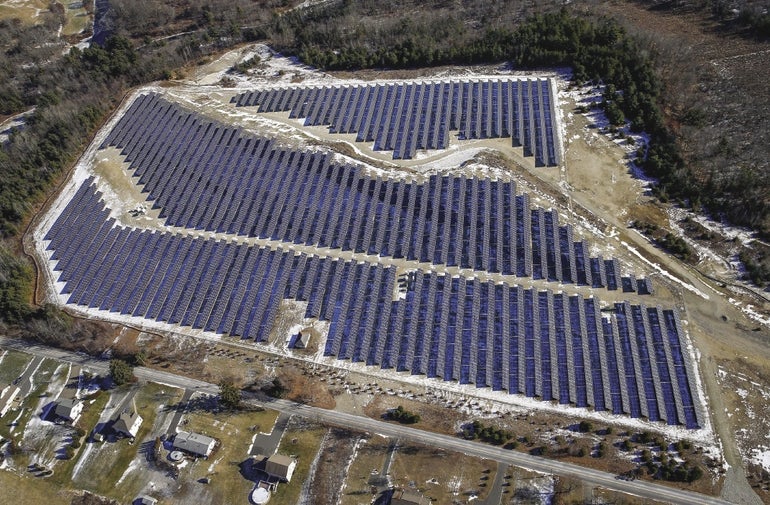Solar industry fears price spikes, job losses
 Courtesy
This six-megawatt solar array in Palmer is the largest in the state bulit on a brownfield. Borrego Solar developed it under the SREC program, which is nearing its limit.
Courtesy
This six-megawatt solar array in Palmer is the largest in the state bulit on a brownfield. Borrego Solar developed it under the SREC program, which is nearing its limit.
Central Massachusetts solar installers and equipment providers said continued loss of state subsidies and the slow reaction of the Massachusetts legislature will soon lead to a spike in renewable energy prices and job losses in the solar industry, even as renewable employment and development have taken off statewide.
The latest concern is over one particular state incentive, called solar renewable energy certificates, which are sold by solar panel owners to utility companies, who then use them to meet their state obligation for clean energy generation. The savings are twofold for panel owners – they are able to save on their electric bills as well as sell their SRECs for profit. The limit for commercial projects is in sight, but residential solar owners can still take advantage of the program.
Solar installers said this, plus the fact that the cap on a billing program for solar was hit in National Grid's territory last April, could lead to a loss in jobs for the industry and declines in solar development statewide.
“People who are professionals in the solar space only will often lose their jobs, there's just no way around it,” said Sascha Deri, president and CEO of Boxboro solar equipment provider AltE. “So much is tied up in the incentives.”
Solar economic outlook
Job growth in Massachusetts' solar industry was strong last year, according to data from the Solar Foundation. The study ranked Massachusetts second in the country for number of solar jobs per capita, at 15,095 jobs. Most of those jobs were in installation (58 percent), while project development (19 percent) and manufacturing (14 percent) had significant employment.
The eastern part of the state had the largest concentration of solar jobs – Middlesex County had 4,212 and Suffolk had 1,937, followed by Essex (1,455), Norfolk (1,367), Bristol (1,121) Worcester (1,095) and Plymouth (1,014). The remaining three counties all had less than 1,000 solar employees.
This is good news for Massachusetts, said Nate Watters, public affairs manager at national solar systems provider SolarCity, and is especially remarkable because the Bay State is by no means the sunniest in the U.S. That means the growth of solar can be chalked up largely to support from the state government, Watters said, but the future is uncertain.
“When you look at what's going on in Massachusetts, going forward it's nothing but market uncertainty, specifically in commercial markets,” he said.
The semi-capped billing program is called net metering, which allows solar-powered businesses to sell excess electricity they generate back to the grid at retail rates.
Net metering hit its cap in National Grid's territory last April, but the cap hasn't yet been hit in Eversource Energy's territory.
Though solar advocates say this has effectively stalled the industry statewide, National Grid reported strong solar growth in its area even after it reached its cap. The utility interconnected 12,000 solar projects last year, more than the previous four years combined.
Although it is important to note that though the SRECs have nearly hit their limit, development won't stall right away because a lot of SREC projects are in the pipeline – some of them haven't started yet, said Mary-Leah Assad, a National Grid spokesperson. The fact that the SREC limit is in reach – sooner than expected, she said – is a sign that the commonwealth's solar incentives are generous.
Customers who take advantage of net metering are reimbursed at the retail rate, which means power plus the cost of the grid.
Utility companies say this puts non-solar ratepayers at an unfair advantage because the cost of the grid is then passed on to them. National Grid's non-solar customers paid over $282 million towards solar subsidies in 2015; that number is expected to increase to $326 million this year.
“Now is the time to look at the commonwealth's solar programs and ensure that they will help us continue growth while setting up policies that are sustainable and affordable for the long-term,” Assad said.
According to a report called “Solar on Superstores” commissioned by Environment Massachusetts' Research and Policy Center and energy research firm Frontier Group, the Solar Energy Industries Association reported the average cost of a non-residential solar panel was $2.07 per watt in the third quarter of 2015, a 9-percent decrease from the same quarter the year prior.
Cost without subsidies
Michael Hannon, who runs Design With Nature LLC, a solar installer in Barre, has been doing solar installations for five years. He hopes SRECs will be extended and that net metering caps will be raised, because otherwise it will take the solar panel owners he sells to twice as long to pay off their systems.
“If solar producers do not receive full net-meter value for power when they overproduce, and the SRECs go away, the solar sector will be hit hard,” he said.
Hannon is frustrated by what he sees as a lot of inactivity going on at the state level. Both legislative bodies on Beacon Hill passed their responses to the solar industry's calls for higher caps on net metering in November, but they were unable to come to a compromise before they broke for the holidays, and instead established a bicameral committee to hammer out the details. However, Sen. Ben Downing (D-Pittsfield) the committee's chair, told the State House News Service if the solar issue isn't resolved in the conference committee, it might end up being part of a larger energy bill later this year.
Katie Gronendyke, press secretary for the Massachusetts Executive Office of Energy and Environmental Affairs, said the Baker Administration is committed to making sure the end of this phase of the SREC program is managed smoothly, and the administration it will work with the legislature.
“We look forward to working with the legislature on the administration's proposal to build upon the success and continued growth of Massachusetts' solar industry while ensuring a long-term, sustainable solar program that facilitates industry growth and minimizes ratepayer impact,” she said.
Watters said that's not good enough.
“Frankly, we need a resolution, and we need it now,” he said.













0 Comments